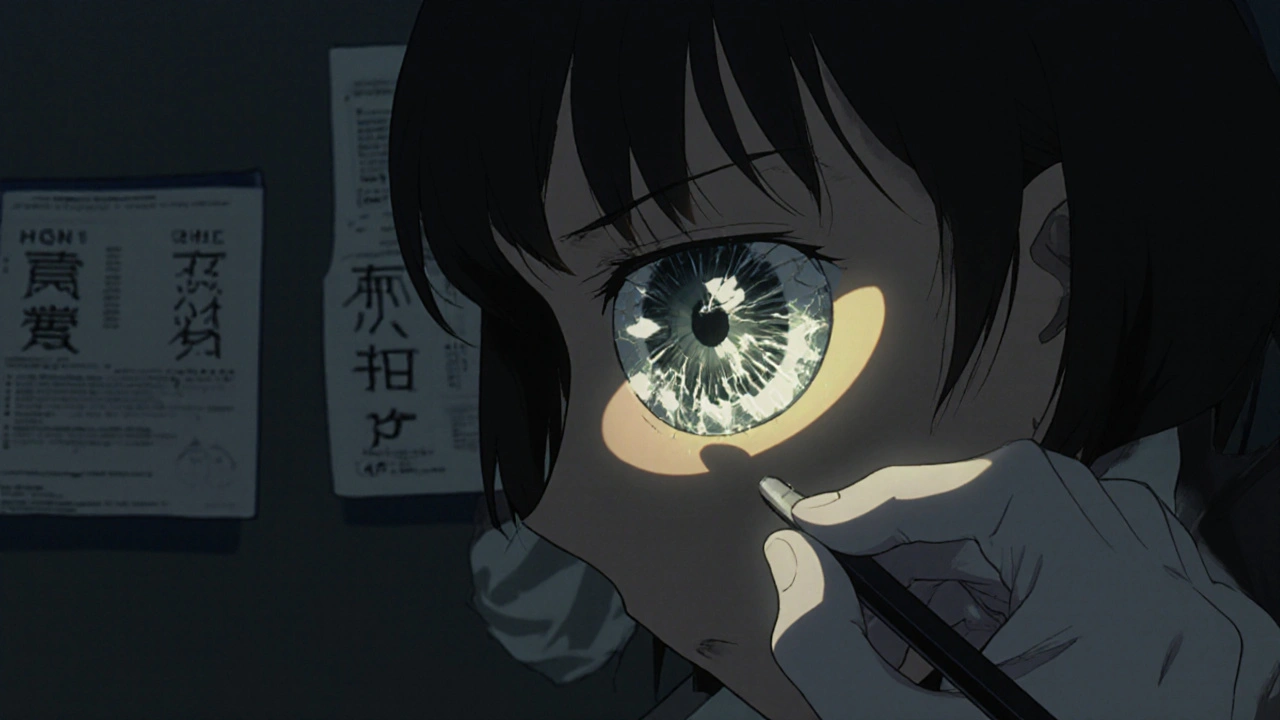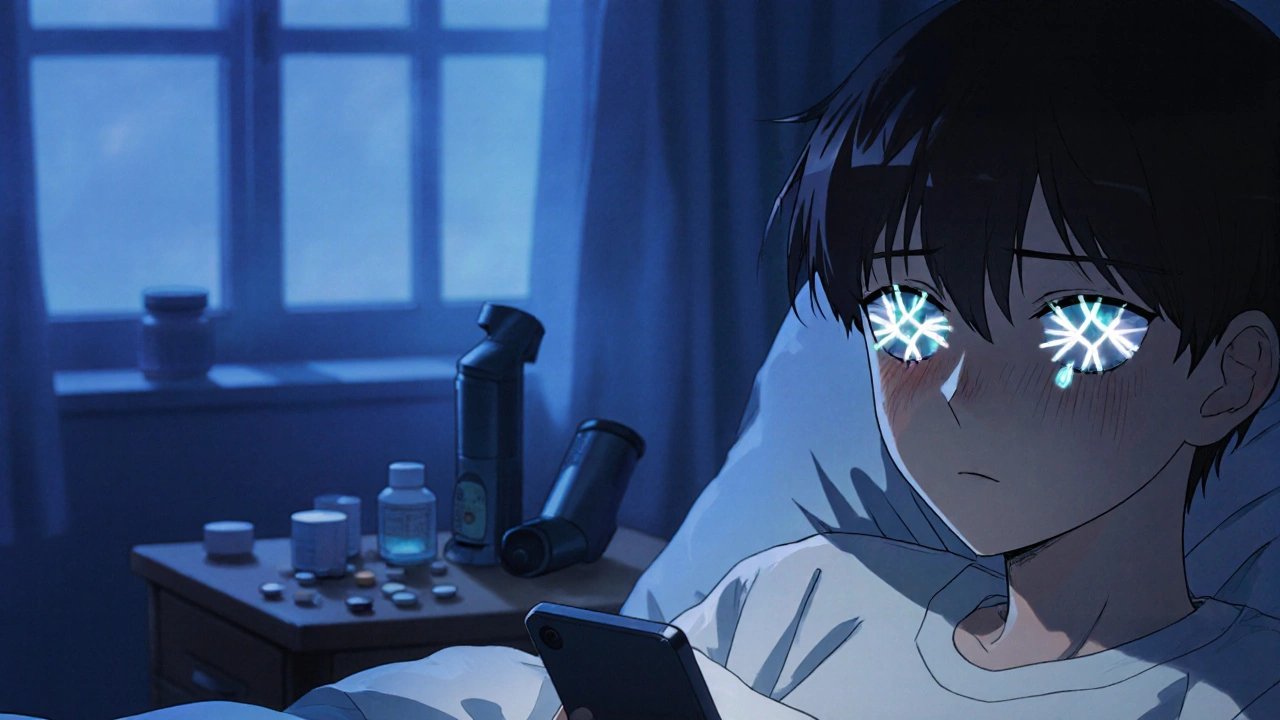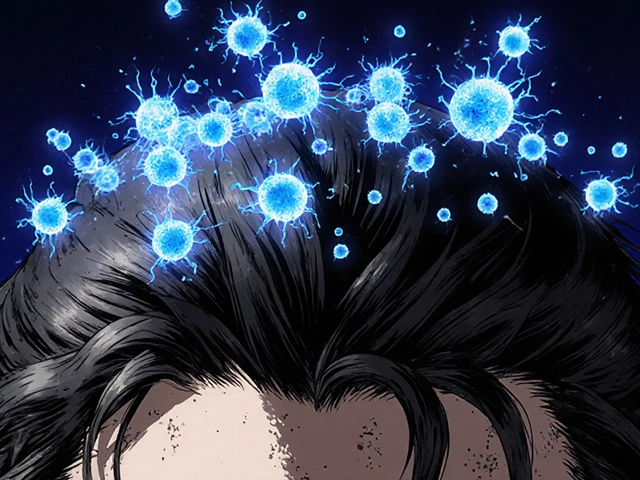Steroid-Induced Cataract Risk Calculator
This tool estimates your risk of developing steroid-induced cataracts based on factors discussed in the article. Your risk increases with higher cumulative steroid dose, longer treatment duration, and certain types of steroid therapy.
Important: This is for informational purposes only. Always consult your doctor for medical advice.
What Are Steroid-Induced Cataracts?
Steroid-induced cataracts are a type of clouding in the eye’s natural lens caused by long-term use of corticosteroids. Unlike the slow, age-related cataracts most people think of, these can develop in just a few months - sometimes as quickly as 2 to 4 weeks after starting treatment. They’re not rare. About 1 in 10 people on long-term steroid therapy will get them, and they’re one of the most common eye side effects of steroids used for asthma, arthritis, eczema, or autoimmune diseases.
The key difference? These cataracts form in the back of the lens, right where light enters. This is called a posterior subcapsular cataract (PSC). Even a tiny spot of cloudiness here can cause major vision problems because it blocks light directly. That’s why someone with a small steroid-induced cataract might struggle with reading or driving at night, while someone with a larger age-related cataract might still see okay during the day.
How Steroids Damage the Lens
Steroids don’t just sit there - they react with proteins inside the lens. The exact process is complex, but here’s the simple version: the chemical structure of steroids like prednisone or beclomethasone binds to lens proteins in a way that doesn’t happen with any other type of cataract. This creates stubborn clumps that scatter light instead of letting it pass through cleanly. Think of it like putting frost on a window - the glass is still there, but you can’t see clearly through it.
On top of that, steroids reduce the eye’s natural defenses. The lens has no blood supply, so it relies on its own internal cleanup system to remove damaged proteins. Steroids slow that process down. They also lower levels of antioxidants like glutathione, which normally protect the lens from everyday damage from sunlight and oxygen. Over time, this imbalance causes proteins to stick together, forming the cloudy patches that define cataracts.
What Does It Feel Like? Key Symptoms
If you’re on steroids and your vision is changing, watch for these signs:
- Blurry vision - especially up close, like when reading a book or phone screen
- Glare and halos - lights look fuzzy or surrounded by rings, making night driving dangerous
- Faded colors - reds look dull, whites seem yellowed, and contrast between dark and light text disappears
- Double vision - even with one eye closed
- Difficulty seeing at night - worse than just being tired
- Reduced peripheral vision - like looking through a tunnel
These symptoms don’t come on slowly. If you’ve been on steroids for 4 months or more and suddenly find yourself squinting at your phone or avoiding night drives, it’s not just aging. It’s likely steroid-induced cataracts.

Who’s at Highest Risk?
Not everyone on steroids gets cataracts - but some groups are much more vulnerable:
- People using topical eye drops - These carry the highest risk. Studies show they’re over 3 times more likely to cause cataracts than oral or inhaled steroids, even at low doses.
- Those on high doses - Taking more than 2,000mg of beclomethasone (or equivalent) over months significantly raises risk.
- Children - Their lenses are more sensitive. Long-term steroid use for conditions like nephrotic syndrome or severe eczema often leads to early cataract development.
- People with diabetes or uveitis - These conditions already stress the eye. Steroids make it worse.
- Those with artificial lenses - If you’ve had cataract surgery before, steroids can cause clouding around the implant, called posterior capsular opacification, which mimics cataract recurrence.
It’s not just about how long you’ve been on steroids - it’s about how much you’ve taken in total. Cumulative dose matters more than daily dose.
Can You Reverse It Without Surgery?
Once the protein clumps form, no eye drops, supplements, or lifestyle changes can clear them. The lens has no way to repair itself. Stopping steroids might stop further damage, but it won’t undo what’s already there.
Some people hope antioxidants like vitamin C or lutein will help. There’s early research, but as of 2025, no study has proven they prevent or reverse steroid-induced cataracts. The London Cataract Centre confirms: no proven medical treatment exists besides surgery.
That said, reducing steroid use - if your doctor agrees - can prevent the cataract from getting worse. For example, switching from oral prednisone to an inhaled version for asthma, or using the lowest effective dose for the shortest time possible, lowers your risk. But never stop steroids cold turkey. That can trigger dangerous flare-ups of your original condition.
Surgery: The Only Real Solution
If your vision is affecting your daily life - reading, driving, working - surgery is the only reliable fix. It’s the same procedure used for age-related cataracts: the cloudy lens is removed and replaced with a clear artificial lens (IOL).
Success rates are high. About 92% of patients report major improvements in vision after surgery. Colors come back. Glare fades. Night driving becomes safe again.
But here’s the catch: if you’re still on steroids after surgery, the new lens can still get cloudy over time. That’s why doctors monitor you closely. In some cases, a second procedure - a YAG laser capsulotomy - is needed to clear cloudiness around the implant. This is quick, painless, and done in the clinic.
Most people recover vision within days. Full healing takes about 6 weeks. You’ll need to use antibiotic and anti-inflammatory eye drops for a few weeks after surgery, and avoid heavy lifting or rubbing your eye.

Prevention and Monitoring
Early detection is everything. If you’re on long-term steroids, you need regular eye exams - not just when you notice problems.
The Mayo Clinic recommends:
- Get a baseline eye exam before starting steroid therapy if it’s expected to last more than 2 weeks.
- Have a follow-up every 3 to 6 months while on treatment.
- Ask your ophthalmologist to check specifically for posterior subcapsular changes using a slit-lamp - a special microscope that can see tiny lens changes before you feel symptoms.
Many people don’t know this, but your prescribing doctor and your eye doctor should be talking. Coordinated care reduces vision loss by up to 37%, according to 2022 clinical data. If your rheumatologist or pulmonologist doesn’t mention eye checks, ask. Don’t wait for blurry vision to be your wake-up call.
What About Inhaled or Nasal Steroids?
Yes, they can cause cataracts too. Even though they’re meant to act locally, some of the drug gets absorbed into your bloodstream. The 2024 study from Saudi Arabia found that 68% of people who developed steroid-induced cataracts were using topical or inhaled steroids - not oral ones. Many patients didn’t realize this was even possible.
If you use an inhaler for asthma or a nasal spray for allergies, rinse your mouth after use and use the lowest dose that controls your symptoms. It’s not about avoiding the medicine - it’s about using it smartly.
Final Thoughts: Balance Is Everything
Steroids save lives. They control inflammation that could lead to blindness from uveitis, or organ damage from lupus. The goal isn’t to avoid them - it’s to use them safely.
If you’re on steroids, don’t panic. But do be proactive. Get your eyes checked regularly. Know the symptoms. Talk to both your prescribing doctor and your eye doctor. And if your vision changes, don’t brush it off as ‘getting older.’ It might be something treatable - and reversible - with surgery.
Most people who get steroid-induced cataracts go on to live full, active lives after surgery. The key is catching it early and acting before it steals your independence.
Can steroid-induced cataracts go away on their own?
No. Once the lens proteins have clumped together due to steroid exposure, the clouding is permanent. Stopping steroids may prevent further damage, but it won’t clear existing cataracts. The only proven way to restore vision is surgical removal of the cloudy lens and replacement with an artificial one.
How long does it take for steroid-induced cataracts to develop?
They can appear as early as 2 to 4 weeks after starting steroid treatment, especially with high-dose topical eye drops. Most people develop noticeable cataracts within 4 to 6 months of continuous use. The risk increases with total cumulative dose - meaning the longer and stronger the treatment, the higher the chance.
Are steroid-induced cataracts different from regular cataracts?
Yes. Regular cataracts usually form slowly over years and start at the edges of the lens. Steroid-induced cataracts form quickly in the back of the lens (posterior subcapsular), right in the path of incoming light. This makes them more disruptive to vision at smaller sizes. They also affect younger people and those on long-term steroids, unlike age-related cataracts which typically appear after 60.
Can I still use steroid eye drops if I’ve had cataract surgery?
Yes, but with caution. After cataract surgery, steroid eye drops are often prescribed to reduce inflammation and prevent rejection of the new lens. However, long-term use can cause clouding around the implant (posterior capsular opacification). Your eye doctor will monitor you closely and may use a laser treatment to clear this cloudiness if it develops. The key is using the lowest effective dose for the shortest time.
Is cataract surgery safe if I’m still on steroids?
Yes, it’s safe. Many patients have cataract surgery while still on steroids. The surgery itself isn’t affected by steroid use. However, healing might be slightly slower, and there’s a higher chance of needing a follow-up laser procedure later to clear cloudiness around the new lens. Your surgeon will plan for this and adjust post-op care accordingly. The benefits of restored vision usually far outweigh the risks.




Andrew Forthmuller
November 13, 2025 AT 16:09Elizabeth Buján
November 15, 2025 AT 14:15Mark Rutkowski
November 16, 2025 AT 22:27manish kumar
November 18, 2025 AT 00:38Arpita Shukla
November 18, 2025 AT 07:23Benjamin Stöffler
November 19, 2025 AT 16:40Alex Ramos
November 21, 2025 AT 15:13Nicole M
November 22, 2025 AT 03:11edgar popa
November 23, 2025 AT 05:52David Barry
November 23, 2025 AT 11:53Alyssa Lopez
November 24, 2025 AT 05:27vanessa k
November 24, 2025 AT 16:25Ryan Everhart
November 26, 2025 AT 14:10Eve Miller
November 27, 2025 AT 13:16